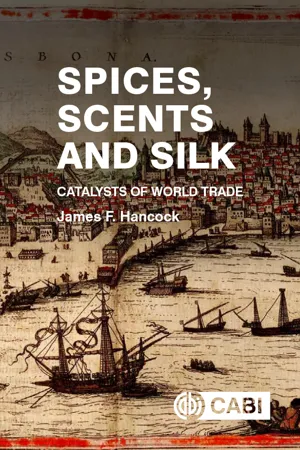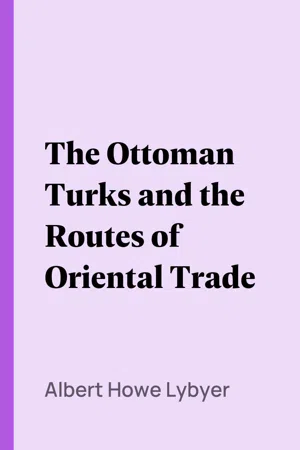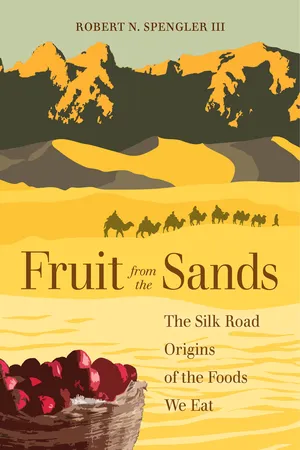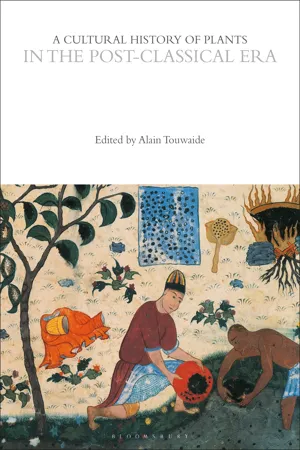History
Spice Route
The Spice Route refers to the network of sea and land routes that connected the East and the West for the trade of spices, silk, and other valuable goods. It played a crucial role in shaping the economies and cultures of the regions it connected, including Asia, Africa, and Europe. The Spice Route facilitated the exchange of goods, ideas, and technologies, contributing to the development of global trade and cultural exchange.
Written by Perlego with AI-assistance
Related key terms
Related key terms
1 of 4
Related key terms
1 of 3
6 Key excerpts on "Spice Route"
- eBook - ePub
Spices, Scents and Silk
Catalysts of World Trade
- James Hancock(Author)
- 2021(Publication Date)
- CAB International(Publisher)
6 Origins of the Spice Trade in the Indian Ocean Setting the Stage – Central Role of RiversThe ancient civilizations of Egypt, Mesopotamia and Harappa all evolved along mighty rivers that provided rich alluvial soils, irrigation waters and transportation. The Tigris and Euphrates Rivers were the backbone of ancient Sumer and the Mesopotamian kingdoms that followed. The ancient Harappa civilization relied on the Indus River. The Nile served as the lifeblood of the Egyptian kingdoms. These rivers fed the agricultural productivity of these great states and served as a vehicle to move grain, ores, stone and luxury products.Ultimately, these great societies became connected by their seafarers following their rivers through linking seas and gulfs to the Indian Ocean. Once linked, they became united through maritime trade. This trade was driven by the human desire for the exotic – manufactured goods, precious stones, metal ores, unusual animals and spices. In particular, the spices cinnamon, ginger and pepper came to generate the lion’s share of profits to the merchants willing to tackle the treacherous sea journeys. The movement of these spices came to be known as the ‘Spice Route’ and eventually spanned 15,000 kilometres (9300 miles) from the west coast of Japan, through the islands of Indonesia, around India to the Middle East and across the Mediterranean to Europe.Persian Gulf RoutesWater transport down the Tigris and Euphrates was likely born about 6000 years ago to transfer copper from the Ergani mines in Anatolia to the southern Sumerian settlements around Uruk in southern Iraq. Travel down the turbulent rivers would have been rapid with prevailing north to south winds; upstream travel would have been very difficult. The earliest vessels of the Mesopotamians were made of reeds or skins to prevent their hitting the bottoms of shallows (Paine, 2013 - eBook - ePub
The Ottoman Turks and the Routes of Oriental Trade
from The English Historical Review, October 1915
- Albert Howe Lybyer(Author)
- 2016(Publication Date)
- Perlego(Publisher)
Each group had branches which entered Asia near Aleppo and diverged in the direction of Tabriz and Bagdad. On all routes there were what in America are compendiously termed ‘long hauls’ and ‘short hauls’; that is to say, wares which travelled most of the way, as Western silver and coral and Eastern silk and spice, and wares which travelled only part of the way, as sugar, cotton, and Arabian gums. It was possible, also, for merchants who dealt in goods of the former class to travel the whole road or to go only part of it and sell or exchange their commodities, which would be carried on by other hands. For most goods the southern routes, especially that by the Red Sea, were cheaper, because they ran mostly by sea; 1 but this consideration was less important in the case of the costlier spices, especially as they were liable to suffer damage in the holds of ships. It was not so much, however, the question of expense as political and religious conditions which determined what routes would be preferred - eBook - ePub
From Jicama to Jackfruit
The Global Political Economy of Food
- Kimberly A. Weir(Author)
- 2015(Publication Date)
- Routledge(Publisher)
Become Abu Al-Qazzaz to experience life as a Muslim spice trader in the fourteenth century. In the computer simulation at Spice Trade (http://www.spicetrade.org), Abu navigates the streets of Baghdad to build a spice business, encountering the trials and travails of European encroachment into the business. This game offers a more personal look at the effect of increased European competition with Muslim traders.As with cocoa beans during the time of Aztec and Inca rule, spices were a form of exchange because they held an immediate, usable value in a way that metals in the Americas did not. The indigenous Indians, who were surrounded by land with abundant gold and silver, placed a much higher value on the labor-intensive, rarer cocoa bean. For this same reason, exotic spices were highly valued by the Europeans, driving them to find and control the source of the supply.Once the Europeans gained sea access to the source, control of the spice trade shifted hands, eventually pushing the Muslim merchants out of the picture. The Portuguese were the first to enter the spice trade, followed by the Dutch, who came to monopolize the trade through their Dutch East India Company (Vereenigde Oost-Indische Compagnie). By the early eighteenth century, the British and French had moved in on the Dutch by creating their own East India trading companies and globally expanded their empires. Eventually spices became so readily available in Europe that they lost their exotic appeal, making them affordable to commoners.The European demand for spices considerably increased the flow of goods between Europe and Asia. As a result, the spice trade laid the foundation for the modern international monetary system. This exchange created the first global trade networks by generating a demand for trade standardized through a new monetary system of currency, commercial credit, and even early corporations.1 - eBook - ePub
Fruit from the Sands
The Silk Road Origins of the Foods We Eat
- Robert N. Spengler III(Author)
- 2019(Publication Date)
- University of California Press(Publisher)
3 I treat these earlier iterations of the Silk Road as precursors of the historical routes, and I give cultural exchange during the second and third millennia equal prominence with that of later periods. Over the past two millennia, control over the lands of the Silk Road, with their expansive deserts and mountain ranges, has passed back and forth between various political and ethnic groups, including successive East Asian empires and Central Asian political entities, such as the Xianbei and Xiongnu. This ebb and flow of cultures shaped human history in myriad ways, including the spread of agricultural practices and crop varieties.The Silk Road was not a road, nor was its main commodity silk. The popular image of long ribbons of camel caravans connecting Xi’an with Rome is just one of its temporal iterations. I define the Silk Road loosely, as a cultural phenomenon of exchange and interaction starting in the third millennium BC and intensifying during the first millennium BC, as exchange and mobility (in various forms) turned Central Eurasia into a complex social arena. The gradual increase in human mobility across Inner Asia, initially propelled by the spread of horse transport, seasonal human migration, and small-scale agropastoralism, played a significant role in shaping human history. Prehistoric Central Asians connected the far corners of the ancient world and spread innovations across it. Among the many ideas and technologies they picked up was the knowledge of how to grow and experiment with crops. Many of these crops were later transported and introduced to new geographic areas.The chapters that follow trace the seven-thousand-kilometer journey that humans have been embarking upon for millennia (although few merchants likely traveled the entire route). They track the footsteps of European explorers like Marco Polo, Alexander von Humboldt, Sven Hedin, Aurel Stein, Nikolay Przhevalsky, Nikolai Ivanovich Vavilov, Owen Lattimore, and hundreds of thousands of merchants and herders who carried with them the genetic material for new varieties of plant and animal species. The resulting dispersal of organisms by humans was unmatched until the colonial expansion of Europe. Notably, the grain crops they carried would give rise to crop-rotation cycles, increasing the food supply and allowing empires to flourish in both Europe and Asia. Millet became the summer crop of the Persian Empire and the low-class crop of Rome, and wheat became the winter crop of the Han and later dynasties in China. Seeds were kept warm through harsh winters at high elevations and irrigated in some of the driest sands of Asia. - Alain Touwaide, Alain Touwaide(Authors)
- 2023(Publication Date)
- Bloomsbury Academic(Publisher)
Figure 3.2 ). Other land routes crossed southwestern Arabia up to the Gulf of Aqaba, and Palestine up to the Mediterranean Sea, or they proceeded to Transjordan, Damascus, and the Orontes Valley up to Antioch.FIGURE 3.2 The Silk Road and the Trans-Asian trade, from Past Worlds. The Times Atlas of Archaeology (London: Times Books Limited, 1988), 190–1. © Times Books, HarperCollins Publishers (1988), used with permission.The tax codes regulating commercial activity in Byzantium listed the products imported into the Empire from the East. The so-called Alexandrian Tariff in Justinian’s Digest (533) enumerated, under the title Species pertinentes ad vectigal (Types [of products] Subject to Taxation), goods (chiefly spices) that were subjected to a 25 percent tax in Alexandria. Although the Tariff does not cite all the spices traded from the East and Arabia to Byzantium, it is a good indicator of the substances in demand for medical and culinary uses in the eastern Roman Empire. Among the plants of Asian origin and their by-products, were cinnamon bark, long and white pepper, folium pentasphaerum (perhaps nard-leaf), folium barbaricum (an unidentified Barbary leaf), putchuk, costamomum (an ointment prepared with costum and amomum), spikenard, Turian cassia and cassia bark (Cinnamomum aromaticum), myrrh, amomum, ginger, malabathrum (possibly cinnamon leaves), aroma indicum (an unspecified Indian product), galbanum and asafoetida (Ferula spp.), aloe-wood, sarcocolla (Astragalus gummifer), cardamom, and xylocinnamomum, that is, cinnamon-bark. Besides these spices, Byzantine trade with the East also included linen, raw cotton fabrics, and opia indica vel serica- eBook - ePub
Global Trade
Past Mistakes, Future Choices
- Greg Buckman(Author)
- 2013(Publication Date)
- Zed Books(Publisher)
18Trade between Europe and Africa also stretches back a long way. By the eleventh century there were permanent international trading colonies in Syria, North Africa, Byzantium and Western Europe that linked the two continents.19 By the fourteenth and fifteenth centuries Mediterranean cities such as Barcelona, Venice and Genoa were regularly trading with eastern Mediterranean centres20 and there had long been trade across the Mediterranean that linked with the trans-Saharan trade route across Africa. The Ottoman empire was also a major conduit for trade between Africa and Europe.Moves towards European international exploration and tradeDuring medieval times it seemed that the part of the world most likely eventually to link together all the world’s separate continental trade networks was not Europe but China. Beginning in the tenth century the Chinese provinces of Guangdong and Fujian began to engage in a lot of international trade supported by an increasingly large and adventurous Chinese merchant fleet that was mainly based in the ports of Fuzhou, Quanzhou and Guangzhou.21 Throughout the fourteenth and fifteenth centuries Chinese merchants sailed as far as the east coast of Africa and, some believe, even rounded the Cape of Good Hope.22 The Chinese suddenly stopped their global exploration in 1433, however, partly because of internal disagreement about the wisdom of expansionism and partly because of the growing Mongol threat to their northern frontiers.23 In contrast to the Chinese adventurousness, the medieval merchants of Europe were fairly inward-looking and conservative and conducted little trade with the rest of world; it would have seemed unlikely, during those times, that they would ever come to dominate global trade. By the fifteenth century, however, the merchants and mariners of Europe had become much more outward-looking. A key element in their new daring was the development of a type of fully rigged ship that combined the square-rigged tradition of northern Europe with the triangular (lateen) rigged tradition of southern Europe.24 The new ships could sail closer to the wind, were faster, more manoeuvrable and more seaworthy than previous ships, and they required smaller crews.25 These ships were known as ‘caravels’ and were crucial in enabling European exploration of the Atlantic for the first time.26
Index pages curate the most relevant extracts from our library of academic textbooks. They’ve been created using an in-house natural language model (NLM), each adding context and meaning to key research topics.
Explore more topic indexes
Explore more topic indexes
1 of 6
Explore more topic indexes
1 of 4





